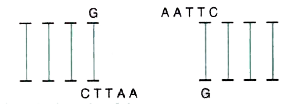An interesting property of restriction enzymes is molecular cutting. Restriction enzymes typically recognise a symmetrical sequence of DNA.

Notice that the top strand is the same as the bottom strand, but reads backward. When the enzyme cuts the strand between G and A, it leaves overhanging chains :

(a) What is this symmetrical sequence of DNA known as?
(b) What is the significance of these overhanging chains?
(c) Name the restriction enzyme that cuts the strand between G and A.
Video Solution
Text Solution
(a) Palindromic nucleotide sequence/ Recognition sequence.
(b) DNA fragments from two different molecules which have the same kind of sticky ends or overhanging chains can be joined together (end to end) by DNA ligases.
(c) feaR!.
|
Topper's Solved these Questions
- BIOTECHNOLOGY : PRINCIPLES AND PROCESSESBOOK - ICSECHAPTER - BIOTECHNOLOGY : PRINCIPLES AND PROCESSESEXERCISE - PRACTICE QUESTIONS (VERY SHORT ANSWER TYPE QUESTIONS)
16 Videos
- BIOTECHNOLOGY : PRINCIPLES AND PROCESSESBOOK - ICSECHAPTER - BIOTECHNOLOGY : PRINCIPLES AND PROCESSESEXERCISE - PRACTICE QUESTIONS (SHORT ANSWER TYPE-I QUESTIONS)
13 Videos
- BIOLOGY-2016BOOK - ICSECHAPTER - BIOLOGY-2016EXERCISE - PART-II ( SECTION-C)
9 Videos
- BIOTECHNOLOGY AND ITS APPLICATIONS BOOK - ICSECHAPTER - BIOTECHNOLOGY AND ITS APPLICATIONS EXERCISE - COMPETITION CORNER (OBJECTIVE TYPE QUESTIONS (ASSERTION AND REASON TYPE QUESTIONS))
9 Videos
Similar Questions
Knowledge Check
Which of the following sequences is recongnised by restriction enzyme BamHI ?
A5'−G↓AATTC−3'3'−CTTAA↑G−5'B5'−A↓AGCTA−3'3'−TTCGAT↑−5'C5'−G↓GATCC−3'3'−CCTAGG↑−5'D5'−CCC↓AAT−3'3'−GGG↑TTA−5'
The restriction enzyme EcoRI recognize following palindrome sequence.
View SolutionAssertion : Restriction enzymes recongise palindromic sequences.
Reason : Palindromic sequences read same in both directions of the two strand.
View SolutionA: Restriction enzymes belong to a larger class of enzymes called nucleases.
R: Each restriction enzymes recognises sequence in the DNA.
View SolutionA: Restriction enzymes belong to a larger class of enzymes called nucleases.
R: Each restriction enzymes recognises sequence in the DNA.
View SolutionName the enzyme that can break and reseal the strands of DNA.
View SolutionRestriction endonuclease ( EcoRI) enzyme cut the strand of DNA
View SolutionThe restriction endonuclease enzyme binds to the DNA and cuts
View Solution
